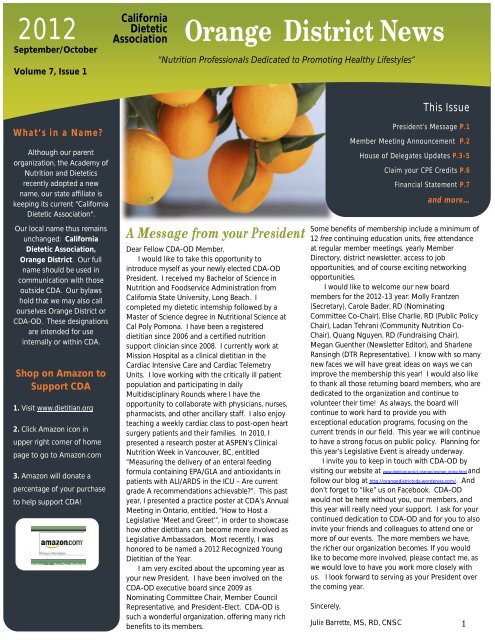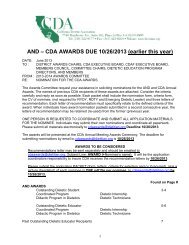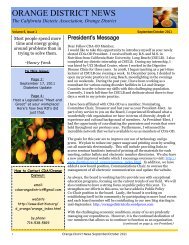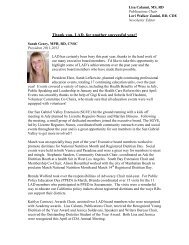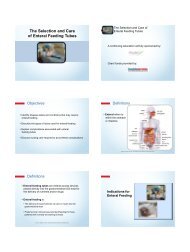OD Newsletter - the California Dietetic Association!
OD Newsletter - the California Dietetic Association!
OD Newsletter - the California Dietetic Association!
- No tags were found...
You also want an ePaper? Increase the reach of your titles
YUMPU automatically turns print PDFs into web optimized ePapers that Google loves.
<strong>California</strong> <strong>Dietetic</strong> <strong>Association</strong>- Orange DistrictOrange DistrictRefocus: ExerciseSaturday, September 22, 20128:00am-12:00pmMission Conference CenterConference Room A & BDirections: 26726 Crown Valley Parkway, Mission Viejo, CA 92691. From Crown Valley Pkwy, make a right on Los Altos. The conference room building willbe on <strong>the</strong> left hand side, parking structure will be straight ahead. Conference room A & B is located on <strong>the</strong> first level. Parking is free.8:00 Registration & Light Breakfast8:30 Introduction8:45 The Bariatric AthleteLea Crosetti, RD, CSSDBariathletes9:45 Female Athlete Triad10:45 BreakTerri Lynn Cole, MSThe Metabolic Treatment Center11:00 The Science and Practice of Bone HealthDr. Jan SchroederProfessor, Department of Kinesiology, Cal State Long Beach12:00 Questions/EvaluationsCost: Free for CDA-Orange District Members$35 for non-members; $15 for retired RDs and $5 for full-time studentsEveryone is welcome!Please RSVP to <strong>the</strong> Evite or by email to dyer.ka@gmail.com or call (602) 820-33642
Public Health Nutrition: It’s Every Member’s BusinessH<strong>OD</strong> Fact SheetHouse of Delegates Mega Issue Fall 2012 – This is a brief discussion of <strong>the</strong> issues your House of Delegate will be reviewing/discussingand making decisions on during <strong>the</strong> Fall Meeting in October. Please review and discuss with your delegate so that your voice cantruly be heard. Thank you for your time and efforts.Credited to Katrina Holt, District of Columbia delegate and Academy Public Health Task Force memberThe Patient Protection and Affordable Care Act signed into law in 2010 promises to change <strong>the</strong> health-care-deliverysystems in <strong>the</strong> United States, partly by shifting focus from disease treatment to disease prevention. Nutrition’s vital rolein preventing diseases and conditions could translate to additional opportunities for registered dietitians as a result ofprovisions in <strong>the</strong> law. Specific dietetics-related areas targeted by <strong>the</strong> law include medical nutrition <strong>the</strong>rapy for chronicconditions and employee-wellness-incentive programs (1).In November 2011, Sylvia Escott-Stump, Academy of Nutrition and <strong>Dietetic</strong>s (Academy) president, appointed a task forceto provide <strong>the</strong> Academy with direction related to public health nutrition. The purpose of <strong>the</strong> task force was to address astrategic priority in <strong>the</strong> Board of Director’s Strategic Plan 2011–2012, which calls for enhancing <strong>the</strong> relevance of publichealth nutrition within <strong>the</strong> Academy and increasing <strong>the</strong> Academy’s visibility in <strong>the</strong> public health community. The taskforce’s charge included developing an action plan focusing on enhancing <strong>the</strong> Academy’s role in public health nutrition(2). One of <strong>the</strong> items in <strong>the</strong> action plan was to submit a mega issue on public health nutrition for a future H<strong>OD</strong> meetingdialogue session.Mega Issue QuestionIn an evolving health services environment, how can our members seize opportunities and provide leadership in publichealth nutrition and community nutrition?Expected OutcomeAcademy members will:1. Recognize, prepare for, and seize opportunities in public health nutrition and community nutrition.2. Be leaders in public health nutrition and community nutrition by actively working in policy development,assessment, assurance, advocacy, environmental change, education, and programs and services.3. Provide input on how to prepare members to meet public health nutrition and community nutrition needs.Defining Public Health Nutrition and Community NutritionOne of <strong>the</strong> task force’s first steps was to come to consensus on definitions of public health nutrition and communitynutrition, terms that are often used interchangeably, although <strong>the</strong>ir meanings differ. In 2003, Roger Hughes wrote that“<strong>the</strong>re have been various attempts in <strong>the</strong> international literature to define <strong>the</strong> field of public health nutrition distinctfrom <strong>the</strong> well established field of clinical nutrition and dietetics” (3). More recently, Roger Hughes and Barrie Margettswrote, “a public health approach is traditionally defined by its focus on prevention ra<strong>the</strong>r than treatment, populationsra<strong>the</strong>r than individuals, and interventions that address <strong>the</strong> determinants of health ra<strong>the</strong>r than <strong>the</strong> treatment of disease”(4). The task force also identified main functions and examples of typical tasks performed by public health nutritionistsand community nutritionists, which are listed below:The main functions of public health nutritionists include:• Taking a leadership role in identifying communities’ nutrition-related needs• Planning, directing, and evaluating health-promotion and disease-prevention efforts• Administering and managing programs, including supervising personnel• Developing and/or assisting in <strong>the</strong> preparation of a budget• Identifying and seeking resources (e.g., grants, contracts) to support programs and services• Providing <strong>the</strong>rapeutic and rehabilitation nutrition services, when <strong>the</strong>se needs are not adequately met by o<strong>the</strong>r partsof <strong>the</strong> health care system• Providing technical assistance/consultation to policymakers, administrators, and o<strong>the</strong>r health agency personnel• Collaborating with o<strong>the</strong>rs to promote environmental and systems changes• Ensuring access to healthy and affordable food and nutrition-related care4
• Advocating for and participating in policy development and evaluation of impacts and outcomes• Participating in research, demonstration, and evaluation projectsExamples• Collaborating with city planners to change environments to increase access, availability, and affordability of healthyfood options, such as providing tax incentives to full-service grocery stores to locate in rural areas• Developing and utilizing surveillance systems to monitor <strong>the</strong> nutritional state of a population group• Developing policies to impact healthy eating and physical activity, such as working with transportation departmentsto promote access to safe, affordable, and healthy food venues• Developing and implementing policies and procedures to promote and support breastfeeding in <strong>the</strong> workplaceThe main functions of community nutritionists include:• Conducting and evaluating nutrition education and counseling for small groups and individuals• Planning, implementing, and evaluating primary and secondary prevention interventions• Providing <strong>the</strong>rapeutic and rehabilitation nutrition services• Administering programs• Participating in care coordination or providing case managementExamples• Conducting food demonstrations/classes for individuals enrolled in <strong>the</strong> Supplemental Nutrition Assistance Program(SNAP)• Training peer counselors or promotoras to promote breastfeeding• Conducting in-service education for school foodservice personnel• Developing nutrition-education activities for <strong>the</strong> school classroom• Providing technical assistance/consultation to health providers on case management for nutrition- and dieteticsrelatedissues• Participating in interdisciplinary teams conducting home visitsSummaryAs health care continues to change, it is important that Academy members recognize <strong>the</strong> long history of public healthnutrition and community nutrition and look ahead toward ensuring that <strong>the</strong>se fields play a vital role in <strong>the</strong> future of <strong>the</strong>dietetics profession.Over <strong>the</strong> next few years, <strong>the</strong> Academy’s Public Health Action Plan will be implemented to help members build <strong>the</strong>irknowledge about and interest in this area of practice. The Academy will work to integrate public health and communitynutrition philosophies, serving communities, including vulnerable and underserved populations, and activitiesthroughout all <strong>the</strong> Academy’s organizational units.What H<strong>OD</strong> Needs from YouTalk with your delegate(s) about this issue in advance of <strong>the</strong> Fall 2012 H<strong>OD</strong> Meeting (October 5–6, 2012). Delegatecontact information is available at www.eatright.org/leaderdirectory. The backgrounder is available atwww.eatright.org/hod > Fall H<strong>OD</strong> Meeting Materials.Monica J. McCorkle, MS, RD, CDE – Delegate Orange District, District 8monicasmagic@cox.net(619) 887-5036References1. Tuma PA. An overview of <strong>the</strong> intentions of health care reform. Journal of <strong>the</strong> Academy of Nutrition and <strong>Dietetic</strong>s.2012;112(3 Suppl):S56–S63.2. Academy of Nutrition and <strong>Dietetic</strong>s, Public Health Task Force. Public Health Nutrition: Action Plan. 2012.3. Hughes R. Definitions for public health nutrition: A developing consensus. Public Health Nutrition. 2003;6(6):615–620.4. Hughes R, Margetts BM. Practical Public Health Nutrition. West Sussex, United Kingdom: Wiley-Blackwell; 2011.5
Claim Your Credits!Do you need to add Orange DistrictContinuing Education Credits to yourProfessional Development Portfolio?Following <strong>the</strong>se steps makes it easy!Information provided by:Christi Coy, MS, RDCDA-<strong>OD</strong> Education Chair1. To perform a general search of <strong>the</strong> database use this link:http://www.cdrnet.org/applications/cpe/index.cfm2. Type "Orange" in "Provider Name contains:"Growth OpportunityA message from your CDA-<strong>OD</strong>Professional MentoringRepresentativeI am sure many of you, like me,always have new ideas ofprojects you would like toimplement in your place of workbut due to <strong>the</strong> amount of workwe all have to complete on adaily basis it can take ages tofinish. Take advantage ofbecoming a Mentor this year byreceiving help from a student ornew RD while <strong>the</strong>y are gainingvaluable experience for <strong>the</strong>irfuture careers in <strong>the</strong> field ofdietetics. For example, I work inLTC and we are switching manyof our documents over frompaper to digital for which means<strong>the</strong>re are hours of data entry tobe done.3. Scroll all <strong>the</strong> way to <strong>the</strong> bottom of <strong>the</strong> form and click"Completed activities only" next to "Show:"Many students needpractice/volunteer hours to getinto internships and new RD’sjust want to gain experience in<strong>the</strong> field. The Mentor benefitsfrom help with projects and <strong>the</strong>Mentee has <strong>the</strong> opportunity togain valuable experience. I willbe preparing a form for Mentorswho are interested. Theopportunities we create will<strong>the</strong>n be emailed to potentialMentors and Mentees. This is awonderful opportunity todevelop <strong>the</strong> professionalmentoring aspect of ourorganization.4. Click "List Activities"Please contact Cristie Coy with questions at: ccoymsrd@gmail.comKathleen Chevalier, RDCDA-<strong>OD</strong> Professional MentoringRepresentativeQuestions? Contact Kathleen at:kachevalier@gmail.org 6
CDA-Orange District Financial Statement 2011-2012RevenueExpenseMembership: $8,241Donations and communityinvolvement: $760Fundraiser: $2,69 Speakers Fees: $2000Vendor Fees and Donations: $1,650 Paid officer positions: $2,400(to be eliminated for <strong>the</strong> 2012-2013Total Revenue: $12,237 ($7,280below expected)year)Total Expense: $12,464 ($7,253below expected)Overall we've had a successful year; as a non-profit it is important that we keep our budgetbalanced and give back to <strong>the</strong> community. We are aligning our system with o<strong>the</strong>r districts andeliminating some of our paid positions, this will free up funds and providing more benefits to ourmembers. Additionally we save money and decrease our environmental impact by 'going green'with our handouts, membership forms, and district rosters.Provided by:Emily J. Haynes, MS, RDTreasurer, CDA-Orange Districtemily.haynesrd@gmail.com7
This is YOUR<strong>Newsletter</strong>.D o y o u l i k e w h a t y o u s e e ?W h a t w o u l d y o u l i k e t o s e e i nt h e f u t u r e ? I s t h e r e a na n n o u n c e m e n t o r m e s s ag ey o u w a n t y o u r f e ll o w C D A - O Dm e m b e r s t o h e a r a b o u t? Iw a n t t o h e a r f r o m y o u ! P l e a s ee m a i l s u g g e s t io n s ,s u b m i s s i o n s a n d a d v e r t i si n gl e a d s f o r t h eN o v e m b e r / D e c e m b e rN e w s le t t e r b y m i d - S e p t e m b e r2 0 1 2 .I l o o k f o r w a r d t o h e a r i n g f r o my o u ,Upcoming EventsOrange District Financial Report 2011-2012CDA-<strong>OD</strong> Study Group First Meeting September 10 th , 2012Please contact Joanne Greenwood, CDA-<strong>OD</strong> Historian and StudyGroup Chair, for fur<strong>the</strong>r information at mcg1127@aol.com or(714)847-3285.CDA-<strong>OD</strong> Member Meeting Dates 2012-2013 (Saturdays)September 22, 2012November 17, 2012March 16, 2013May 18, 201320M e g a n G u e n t h e rC D A - O D N e w sl e t te r E d i t o rm g u e n t h e r @ l i v e . c o mNeed a CDA-<strong>OD</strong> Membership Card? Print and cut out <strong>the</strong> card below.Contact CDA-Orange DistrictEMAIL cdaorangedistrict@gmail.comWEBSITE www.dietitian.org/d_orange/orange_index.html.comBLOG http://orangedistrictcda.wordpress.com/8


